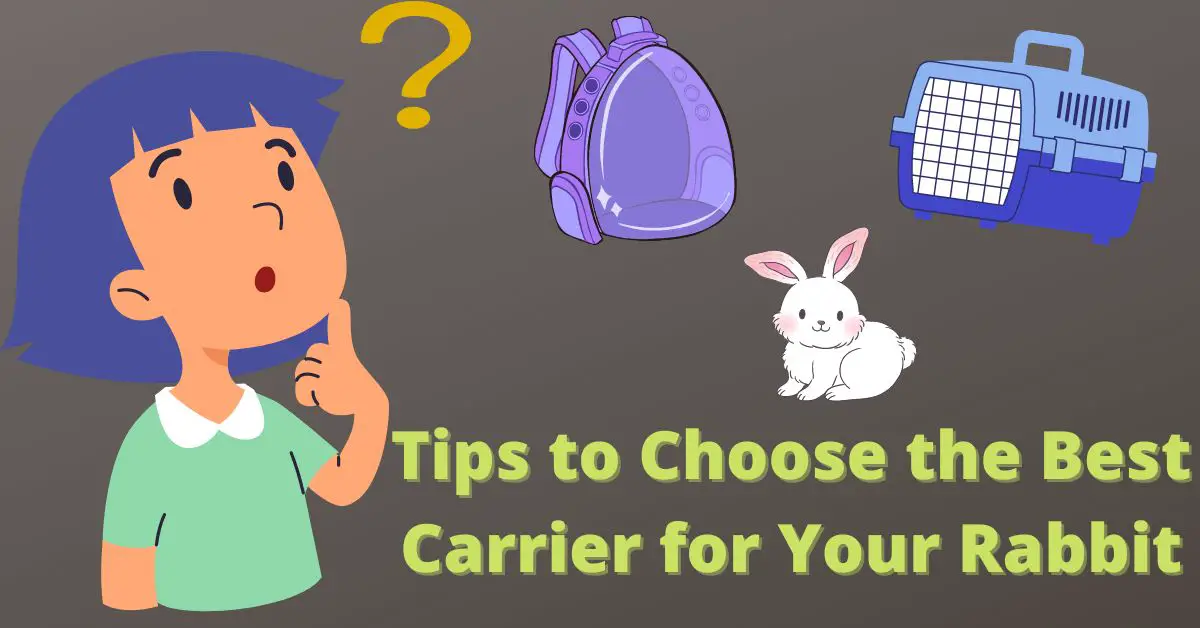Quick Answer: Tips to Choose the Best Carrier for Your Rabbit
A properly sized carrier will allow your rabbit to stand up, turn around, and lay down. I would recommend that you find one with a wire bottom so that it can have proper drainage.
It should have adequate ventilation so that your bunny doesn’t get too hot or too cold while traveling. The case should be easy to disinfect. Things to look for:
– Carrying case size (measured by length, not just width)
– chew proof materials
– ability to separate the parts so they may be properly cleaned (not all come apart)
– a sturdy door that will lock in place
Introduction: Tips to Choose the Best Carrier for Your Rabbit

Rabbits can get scared, stressed, and angry when traveling to a vet clinic or an unknown destination. They take time to get accustomed to new surroundings. Bunnies are quite sensitive about their living environs, temperature, etc.
Sensing strangers all around, unfamiliar odor, and sounds can rouse a sense of insecurity and fear in buns. Feeling of insecurity and fear is not good for rabbits often leading to severe shock or heart attack.
While you don’t have control over external factors, a safe bunny carrier can keep your furry friend relaxed in comfy surroundings.
Buying a small pet transport cage may seem an easy task. But it is not the case when you visit an online store. If you have adopted a rabbit recently, it is helpful to know the crucial facts before purchasing a carrier for your small pet.
Types of Pet Carriers to Avoid when Travelling with a Rabbit
Before taking look at the various safety-compliant small pet carriers, it makes sense to know the items you should never use for transporting a bunny.
If your bun manages to come out of the carrier when you are busy driving the car, it can get severe injuries.
Cardboard Boxes: It is ok to bring the baby rabbit home in a cardboard box (delivered at the breeder’s place). But it is made for one-time use only. Bunnies have chewing and digging tendencies. They can chew the cardboard easily and escape from the box.
Wicker Baskets: Natural wicker is another favorite chewing material for rabbits. If you are traveling long distances, your bunny will have enough time to dig a hole into the basket and flee away.
Wire Cages: Wire cages are sturdy, so it can be challenging for your small pet to chew the material. However, it is not recommended to keep bunnies on wired floors. They may develop wounds or sores in the feet.
Fabric Carriers: Fabric carriers are sturdier than wicker and cardboard boxes. For instance, a rabbit carrier bag is made of multiple layers of inserts and covers. Buns take a lot of time to chew through the walls. However, if you are on a long-distance trip, avoid using these items.
Things to Look for When Buying a Travel Cage for Pet Rabbits
Pet owners should prioritize the comfort, health, and safety of the little creature when choosing a rabbit carrier. Whether purchasing from an online store or at a retail outlet, you must look out for these vital attributes:
Spacious Interiors
A pet carrier must have sufficient space for your cutie to stay peaceful and comfortable. It can be an aching and stressful experience to travel in a congested small carrier.
Ideally, 19-20 inches long carriers are good for an adult rabbit. But if you own a large breed such as Flemish Giant, go for a bigger one.
Don’t choose a large rabbit transport cage if you have a baby or dwarf breed. Your bunny can slam against the walls of the carrier in case of a sudden stop, jerk, or crash.
Ventilation for Fresh Air and Cooling
Regulating airflow is vital to keep the rabbit travel cage cool. It keeps your bunny comfortable and breathing with ease.
Easy Access
If it is the first outing with your rabbit outdoors, it is natural for the small pet to get scared due to sudden changes in surroundings. In such situations, your bun will move to the extreme corner of the carrier for hiding.
Taking your bunny out at the vet clinic will become impossible if you don’t have access to the entire cage, getting your pet outside can be a strenuous affair.
Small pet carriers with top openings are designed for accessibility without injuring the delicate creature.
Safety Compliant
Are you using a crash test-approved transport cage for your pet?
If not, your small animal is at risk. Unfortunately, most pet carriers are not safe for traveling at all. Your pet may get severely injured when opting for a sudden stop or facing a collision.
Some products are promoted with a crash-tested label but it does not come with any evidence.
Try to get CPS-certified rabbit carrier for your bun. Center for Pet Safety (CPS) is a non-profit and registered safety science and consumer advocacy organization working in areas of pet safety. It is not associated with any pet product brand or industry. The authorities give certification only when the product passes all tests and meets the necessary safety standards.
Simple to Clean
Complicated designs and netted framework often poses difficulty to clean the carrier. All parts of the carrier must be thoroughly cleaned before use for health and hygiene.
Make sure the parts are detachable to clean the interiors of the carrier with pet-safe cleaners.
Ergonomic Handle/Strap
A carry-friendly strap attached to the sides or top eases your job during transportation. Oversized carriers with multiple pets can be too heavy to carry in a lap. It is dangerous too. Check for the handles with robust Velcro straps.
Rabbit Carrier FAQ – Frequently Asked Questions
#1. Is it good to transport two rabbits in the same carrier?
If you have two bonded rabbits living happily together at home, it is good to take them for a vet checkup. You may carry them in the same transport cage. Traveling with a bonded companion gives them a sense of security. There is no boredom when they can play or stay together in a comfy carrier.
#2. Where to place a rabbit travel cage in the car?
The floor behind the driver’s seat is the safest place for housing the small animal carrier in the car. This place has barriers on all sides to support the cage. It prevents the jerk and shocks if you stop the car suddenly.
#3. Why is it vital to keep a rabbit stress-free/calm during travel?
Your bun should feel happy and secure getting and staying inside the carrier. If the toothy friend feels insecure, it will try to escape from the place. This includes actions like jumping, chewing the walls, etc.
If a rabbit is tense or angry inside the transport cage, it will be problematic to get it inside it the next time. In the worst case, it may manage to break through the barriers while you are traveling in a car, bus, train, or airplane.
#4. How to make my bunny familiar with the travel home?
Your bun must feel safe inside the rabbit travel cage to stay calm and happy. Don’t drag or force your cutie to get into the carrier.
Days before you plan a visit to the vet, have a few trials with the new travel case. This will make the carrier as familiar as the living enclosure.
There are simple ways to make your pet used to the environment inside the transport cage. Do this before your small pet gets inside the cage.
- Spread soft, cozy padding (generally provided with the carrier) on the floor of the carrier
Create familiar surroundings inside the travel case with rabbit toys, hay, etc.
Keep the cage near the rabbit habitat. Your bun will assume this is a new hideout or play zone.
- Place some treats or pellets to lure the animal to get inside willingly.
A couple of free rides nearby is also a great idea to make your rabbit used to outdoor travels.




